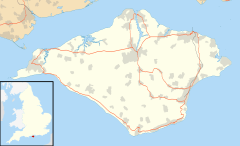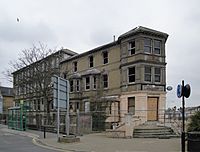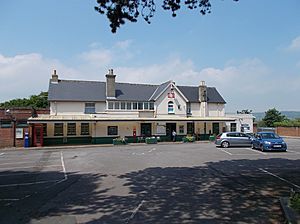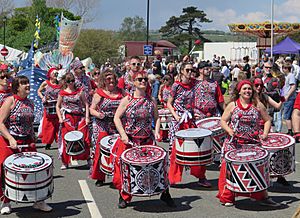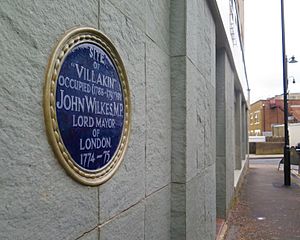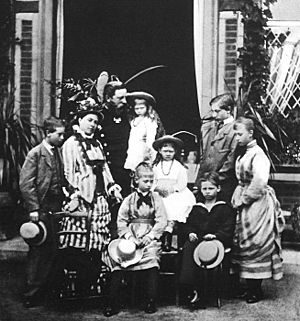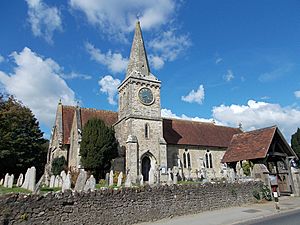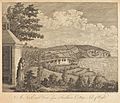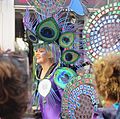Sandown facts for kids
Quick facts for kids Sandown |
|
|---|---|
 One of Sandown's sandy beaches |
|
| Population | 11,868 (2011 Census) |
| OS grid reference | SZ600843 |
| Unitary authority | |
| Ceremonial county | |
| Region | |
| Country | England |
| Sovereign state | United Kingdom |
| Post town | SANDOWN |
| Postcode district | PO36 |
| Dialling code | 01983 |
| Police | Hampshire |
| Fire | Isle of Wight |
| Ambulance | Isle of Wight |
| EU Parliament | South East England |
| UK Parliament |
|
Sandown is a seaside resort and civil parish on the south-east coast of the Isle of Wight, United Kingdom with the resort of Shanklin to the south and the settlement of Lake in between. Together with Shanklin, Sandown forms a built-up area of 21,374 inhabitants.
The northernmost town of Sandown Bay, Sandown has an easily accessible, sandy shoreline with beaches that run continuously from the cliffs at Battery Gardens in the south to Yaverland in the north.
Natural interests
Sandown is a typical Victorian seaside town, but is surrounded by a wealth of natural features. To the north is Culver Down, a chalk down accessible to the public, mostly owned and managed by the National Trust, and supports typical chalk downland wildlife, and many seabirds which nest on the adjoining cliffs. Nearby inland are Sandown Levels, one of the few freshwater wetlands on the Isle of Wight, where Alverstone Mead Local Nature Reserve is a very popular spot for birdwatching. Further inland the woodland of Borthwood provides delightful woodland walks, and bluebells aplenty in the spring.
The most significant wildlife designation in the area is the Special Area of Conservation which covers the marine sub-littoral zone, including the reefs and sea bed. At extreme low tide a petrified forest is partially revealed in the northern part of Sandown Bay, and fragments of petrified wood are regularly washed up on the beach.
History
Originally Sandown was of only military significance as its wide sandy beaches offers a landing place for invasion. One of the first non military buildings was "Villakin", a holiday home leased by the radical politician John Wilkes in the 18th century, which, along with the Royal Pavilion at Brighton began the fashion for seaside holidays. At first only available to the rich, the development of both railways and excursion steamers made such holidays more generally available. Sandown has been a seaside resort town since the Victorian age thanks to its sands and the sunny weather on the Isle of Wight compared to other parts of the United Kingdom. Its success, along with that of other neighbouring Isle of Wight resorts led to the building of a railway connecting Sandown with Ventnor at the south and Ryde on the north coast of the island. Sandown railway station is still on the one remaining operational railway on the island, which now goes from Ryde Pier Head to Shanklin.
Today Sandown esplanade boasts some fine Victorian and Edwardian hotels (many of which have been unsympathetically extended by breeze block annexes) which overlook the golden sands of the beach below. Sandown Pier hosts a large amusement centre with arcade games and children's play areas, typical of a seaside resort. The pier is also well used for sea fishing with designated areas especially for the angler. Further north, there is the Isle of Wight Zoo (also known as Sandown Zoo) which specialises in tigers. Other facilities include an 18-hole golf course, the Dinosaur Isle geological museum and Sandham Gardens, offering a skate park, children's play park, crazy golf, bowls and putting green. In recent years, the town has started to experience urban decay as many of the hotels began to close and be replaced with Care homes, driving away tourists. A grant given to Sandown and Ryde in 2015 has raised hopes of regeneration within the town.
Transport

Sandown railway station is on the Island Line Railway, the Isle of Wight's one remaining public line from Ryde Pier Head to Shanklin.
Sandown is also served by buses run by Southern Vectis on routes 2, 3 and 8 with direct services to Bembridge, Newport, Ryde, Shanklin and Ventnor. Night buses are run on Fridays and Saturdays, along route 3.
Cities links
Sandown is twinned (jumelée in French) with the town of Tonnay-Charente, in the western French département of Charente-Maritime. Its American twin town is St. Pete Beach, Florida.
Notable people
- John Wilkes (former Lord Mayor of the City of London) stayed regularly in Sandown in the late 18th century at the place he called 'Villakin', also known as Sandham Cottage. A memorial plaque marks the site of the cottage close to the present-day High Street. On Sunday mornings, Wilkes would go to Shanklin Church, and after the service would walk across the fields to Knighton with David Garrick and his wife.
- Naturalist Charles Darwin worked on the abstract which became On the Origin of Species when staying at Sandown's King's Head Hotel in July 1858. He and his family later moved on to Norfolk House in nearby Shanklin. Darwin also visited the Isle of Wight on other occasions, and was photographed there by Julia Margaret Cameron in 1868.
- The writer George Eliot (Mary Ann Evans) stayed in Sandown during a two-week visit to the Isle of Wight in June 1863, having recently published her novels Romola and Silas Marner. Her celebrated work Middlemarch was published nine years later.
- Frederick III, German Emperor and his consort Victoria, Princess Royal, when Crown Prince and Princess of Germany, stayed at Sandown with their children for two months in the summer of 1874. Queen Victoria travelled from Osborne House to visit them on 31 July, an event she described in her journals
- The author Lewis Carroll, the Reverend Charles Lutwidge Dodgson, spent successive summers on Sandown sea front in the 1870s, staying first at the King's Head Hotel and later at Culverton House. In 1875, while he was writing The Hunting of the Snark, he met 9-year old Gertrude Chataway whose family was staying next door. The first edition of The Hunting of the Snark is dedicated to Gertrude.
- The composer Richard Strauss (1864-1949) spent summer holidays at Sandown's Ocean Hotel in 1902 and 1903. His sketchbooks show that, while there, he worked on his Symphonia Domestica and themes that found their way into Der Rosenkavalier
- Sir Isaac Pitman worked on his system of shorthand in Sandown in the 1860s
- Cilla Black, Frankie Howerd, Tommy Cooper, Jimmy Tarbuck and Dickie Henderson were among the late 20th century performers doing summer seasons at Sandown Pier Pavilion
- Oscar-winning film director and playwright Anthony Minghella was a pupil at Sandown High School Members of the groups Level 42 and the Bees also went to Sandown High School and began their musical careers in Sandown.
- Edward Upward (1903-2009) long-lived author and part of the Auden Group in the 1930s, lived in Sandown from 1961 to 2004
- James Clutterbuck, cricketer
- William Darwin Fox, naturalist-clergyman, second cousin of Charles Darwin buried in Sandown.
- James Dore (1854-1925), a photographer who recorded hundreds of late Victorian and Edwardian images of Sandown and the Isle of Wight. The Isle of Wight Heritage Service holds a collection of his work Dore was also a local councillor, Justice of the Peace and Sandown's Chief Fire Officer
- Thomas Field Gibson FRG found some important fossils while staying at his beach house at Sandown.
- Eric Charles Twelves Wilson V.C. was born in Sandown.
- Simon Moore, footballer who plays for Sheffield United.
- Mary Ellis, ATA Pilot 1941–1945, later managing director of Sandown Airport. Mary died in July 2018 aged 101
Images for kids
See also
 In Spanish: Sandown para niños
In Spanish: Sandown para niños


